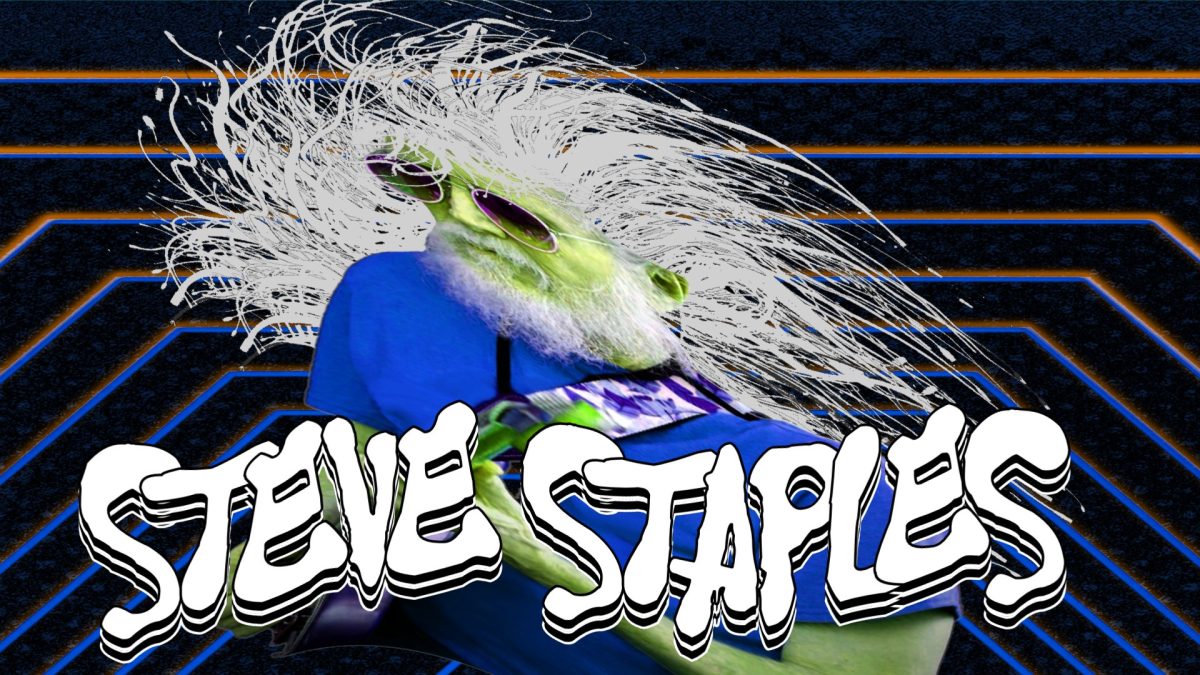As I sat down to write this, I was immediately taken back to an old track that you may be familiar with, Grandma’s Hands, by Bill Withers. It’s a sentimental tune that captures the essence of the matriarch as perceived by a young boy. Though Steve Staples of The Iceman Special will tell you he doesn’t quite remember that far back, he began with a story of how he used to sit on his grandmother’s knee while she played piano. Those hands would produce melodies at home and at church that ingrained music into his being. Of his singing, she would say he could carry a tune by the time he was two. Steve and his mother had moved from Oklahoma to his grandmother’s house in Oakdale, Louisiana immediately following his father’s calling to the 38th parallel to fight in the Korean War. But his first memorable encounter came in 1955 when his family bought a television. He still remembers how Waylon Jennings looked with his guitar and that slicked back hair. Not too long after that, his next-door neighbors would purchase two Fender Esquire guitars and two Fender Pro amps. They would sit on the porch and play. And a young, curious Steve was inexplicably drawn to the sound. How peculiar are the seemingly minute happenings in a child’s life that bear the most impact. Because sitting at the core of Steve Staples, these two moments coupled to ignite a passion that would never be extinguished.
It wouldn’t be until he turned thirteen that he would start playing his own guitar, an acoustic. The following summer, his grandmother bought him an electric guitar and he would put this one to use on stage. Steve fondly recalls, “Myself, Mike King, Ricky Hall, Brian Collins, and Johnny Baker just made up a band for that performance called The Gonks. And we played in our junior high school auditorium about four or five songs that were British invasion kind of songs. And the girls went crazy. I mean, they were all up and dancing in the isles. They went crazy! That was it…. I told Brian, I’m going to do this for the rest of my life!” Though The Gonks were somewhat of a fictitious band, being that they were only formed in name for that show, Steve’s mind was made up. Disbursement would soon affect two popular local bands, The Twilights and The Gaunga Dyns. And through a series of shufflings amongst those members and Steve’s friends, he would finally be in a real band. “There was a band called The Twilights. And there was a band that formed called The Gaunga Dyns, simultaneously. I wasn’t in either one of them. He went on further to say, “We didn’t like our bass player that much. And we liked the bass player in The Gaunga Dyns. And The Gaunga Dyns were going to break up because the two guitar players and singers were going off to college. That was going to be the end of that band. But they were good. So, we broke those two bands up and formed one band, what we called The Gaunga Dyns, not the Twilights. And we had Neil Lundgren and Beau Breamer were singing. And they could sing like the Everly Brothers. I mean they could really sing. They were both super talented. And that was the Gaunga Dyns for a while. And it got real popular really quick.” Neil would leave the band soon after to pursue his own musical interests. But The Gaunga Dyns would go on to record at Cosimo Recording Studio on Gov. Nichols Street, in the French Quarter. Steve laughed as he mentioned that they were on the national charts for about a week or so at number ninety-nine. They had a formula that fit the time, touching on some British invasion tunes, and covering rock and soul genres as well. Steve and Mike King would do the writing for the originals. But a slight change would spell trouble further down the line. Their bass player, Bobby Carter, would end up moving to Connecticut when his father pursued a job opportunity there. And the band would turn to Steve to play bass and sing. He did oblige, but with hesitation. Because he knew this to be a daunting task. When the band called a song on stage that he didn’t feel well-rehearsed enough to play, he walked off. The Gaunga Dyns would kick him out the next day.
At home things were touch-and-go. Steve loved his father but viewed him as silently seething most times. He knew early on in life that his father wanted him to be a lawyer because his father told him so. But this path wasn’t in Steve’s sight. And as time went on, the rift would grow between them much like the separation between his father’s ideals and Steve’s intentions. But there were the occasional touches of sanguinity from time to time. At sixteen, without any warning, his father presented him with a really nice guitar. Which was bizarre considering he had never come to see his son play; not even once. One can only imagine the opinion a rugged war veteran might have had of “musician” as a career path. Ironically, his father had originally wanted to be a painter. Looking back, Steve acknowledges the existence of a softer side. But being a soldier instilled a toughness that made revealing this both obviously difficult and sporadic. The fracture in their relationship may have begun while he was still in school. His father had hopes of Steve joining the R.O.T.C. But Steve would instead choose to go off to college. Later in life, when Steve was quitting his job and turning to the road in pursuit of his desires, his father’s disapproval was more than apparent. He told Steve outright that he was throwing his life away. But again, intermittent gleams of positivity would shine through at times. On the day following this argument, for instance, his father called and said, “You’re right. Go do it.” Though his father’s hopes for him never quite seemed to align with his own, and the support wasn’t always apparent, his father would evidently have a change of heart from time to time. There was another instance where things were already not going as planned for Steve, who was on a path that surely wasn’t set out for him by his father. But he surprised Steve, giving him a van to help him along. The messages always seemed mixed. And it would take years until the relationship with his father would be resolved. Today Steve concedes that the instability between them was answered with his own alcohol and drug abuse.
After the fall out with the Gaunga Dyns, Steve would move with his family back to Oakdale in time for his Senior year of high school. He played guitar in the orchestra there. And get this… he played the string bass too! Life would find him amongst friends and musicians at Louisiana State University that following year. He sold that electric guitar his father bought him, a decision he regrets to this day. But the singer/ songwriter era was in full swing and he used the money to buy an acoustic guitar. Artists like Paul Simon, Van Morrison, and James Taylor owned the day in the late sixties. And Steve was anxious to make his contribution to the art. He would spend his idle time playing and singing with guys on the common ground. One day, he saw a post on a bulletin board in search of a songwriting partner. Through this he would meet and begin working with Quentin Powers, who would go onto work with such greats as Reba McEntire, Ronnie Milsap, and a host of other now famous musicians. The two worked on their own material, hiring friends and other musicians to make a demo at a studio in Baton Rouge. They shopped it around and were basically told it wasn’t good enough. But the second time around they landed a deal with Ardent Studios. With this they would have the opportunity to work with Ron Capone, a drummer whose catalog included work on the Shaft soundtrack with Isaac Hayes. They would also get to work with Steve Cropper, a guitarist, A & R man, engineer, producer, and songwriting partner of Otis Redding, Eddie Floyd and a dozen others and founding member of both Booker T. and the MG’s and The Mar-Keys. Ron was especially enthusiastic about Steve and Quentin’s work. He urged them to move up to Memphis, where Ardent was located, which they did. Things were going well at first. At the time there were a lot of rock and roll clubs. And a lot of hotels and motels had clubs in them. They would hire a band for a week, providing room and board along with pay. Together with their band, Steve and Quentin were able to work consistently while recording their album. But life eventually offset this stasis, sending the members in different directions. And the album they recorded at Ardent never came out. Their bass player would eventually leave town with his girlfriend. His replacement would subsequently leave to become a brain surgeon. Quentin would remain, as did Steve who had by now developed an intravenous methamphetamine habit.
His habit would follow him back to Oakdale, where he would take a job at his father’s car dealership. He once again found someone to play music with and would stick with this guy for a few years until 1980. But he was pulled over and arrested one night, landing him in jail. His lawyer advised seeking treatment. And so began Steve’s life-long path of sobriety. Steve’s complete ethos would align with this new way of life. He became a full-time rehabilitation counselor for twelve years, eventually running programs at different facilities in Louisiana. All the while he found ways to integrate music into his life with other musicians in recovery. In my eyes, his life has read like a success story from this point on. He built a mobile recording studio and travelled the country. He attended Loyola University, where he was in class with Stanton Moore. A band he played in, Merit and the Bloodhounds, won a competition at the New Orleans House of Blues and was flown to Hollywood to perform. He opened a shop, International Vintage Guitars, which operated in New Orleans for twenty years, later moving it to his hometown of Oakdale, Louisiana. It is still in operation to this day. And now he’s playing in a sensational band by the name of The Iceman Special. They’ve been playing numerous dates across the country. I attended one of their performances at Toulouse Theater in New Orleans, and I was truly blown away. Their talent, their stage presence, and their bevy of smoke and laser lighting seized the attention of all, enveloping the audience in an experience I for one will never forget. For the genius that Charley Murray, Will Murray, Steve Staples and Hunter Romero form, and for the wonderful man Steve himself has become, I can’t recommend enough seeing them play. Their new album Zycordia dropped this year. I hope everyone gets a chance to listen.
Author: David Trahan




















